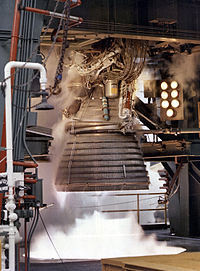
Back J-2 (motor de coet) Catalan J-2 Czech Rocketdyne J-2 German Motor de cohete J-2 Spanish J-2 (rakettimoottori) Finnish J-2 (moteur-fusée) French J-2 (motor foguete) Galician J-2 HE Rocketdyne J–2 Hungarian Rocketdyne J-2 ID
 J-2 test firing | |
| Country of origin | United States |
|---|---|
| First flight | 26 February 1966 (AS-201) |
| Last flight | 15 July 1975 (ASTP) |
| Designer | MSFC/Rocketdyne |
| Manufacturer | Rocketdyne |
| Application | Upper stage engine |
| Associated LV | Saturn IB (S-IVB) Saturn V (S-II and S-IVB) |
| Successor | HG-3 J-2X |
| Status | Retired |
| Liquid-fuel engine | |
| Propellant | Liquid oxygen / Liquid hydrogen |
| Mixture ratio | 5.5:1 |
| Cycle | Gas generator |
| Configuration | |
| Nozzle ratio | 27.5:1 |
| Performance | |
| Thrust, vacuum | 1,033.1 kN (232,250 lbf) |
| Thrust, sea-level | 486.2 kN (109,302 lbf) |
| Thrust-to-weight ratio | 73.18 |
| Chamber pressure | 5,260 kilopascals (763 psi) |
| Specific impulse, vacuum | 421 seconds (4.13 km/s) |
| Specific impulse, sea-level | 200 seconds (2.0 km/s) |
| Burn time | 500 seconds |
| Dimensions | |
| Length | 3.4 metres (11.1 ft) |
| Diameter | 2.1 metres (6.8 ft) |
| Dry weight | 1,788.1 kilograms (3,942 lb) |
| References | |
| References | [1][2][3] |
| Notes | Data is for SA-208/SA-504 version. |
The J-2, commonly known as Rocketdyne J-2, was a liquid-fuel cryogenic rocket engine used on NASA's Saturn IB and Saturn V launch vehicles. Built in the United States by Rocketdyne, the J-2 burned cryogenic liquid hydrogen (LH2) and liquid oxygen (LOX) propellants, with each engine producing 1,033.1 kN (232,250 lbf) of thrust in vacuum. The engine's preliminary design dates back to recommendations of the 1959 Silverstein Committee. Rocketdyne won approval to develop the J-2 in June 1960 and the first flight, AS-201, occurred on 26 February 1966. The J-2 underwent several minor upgrades over its operational history to improve the engine's performance, with two major upgrade programs, the de Laval nozzle-type J-2S and aerospike-type J-2T, which were cancelled after the conclusion of the Apollo program.
The engine produced a specific impulse (Isp) of 421 seconds (4.13 km/s) in a vacuum (or 200 seconds (2.0 km/s) at sea level) and had a mass of approximately 1,788 kilograms (3,942 lb). Five J-2 engines were used on the Saturn V's S-II second stage, and one J-2 was used on the S-IVB upper stage used on both the Saturn IB and Saturn V. Proposals also existed to use various numbers of J-2 engines in the upper stages of an even larger rocket, the planned Nova. The J-2 was America's largest production LH2-fuelled rocket engine before the RS-25. A modernized version of the engine, the J-2X, was considered for use on the Earth Departure Stage of NASA's Space Shuttle replacement, the Space Launch System.
Unlike most liquid-fueled rocket engines in service at the time, the J-2 was designed to be restarted once after shutdown when flown on the Saturn V S-IVB third stage. The first burn, lasting about two minutes, placed the Apollo spacecraft into a low Earth parking orbit. After the crew verified that the spacecraft was operating nominally, the J-2 was re-ignited for translunar injection, a 6.5 minute burn which accelerated the vehicle to a course for the Moon.
- ^ Marshall Space Flight Center. "J-2 engine". NASA. Archived from the original on 10 June 2008. Retrieved 22 February 2012.
- ^ "J-2 Engine Fact Sheet" (PDF). Saturn V News Reference. NASA. December 1968. Archived from the original (PDF) on 8 August 2020. Retrieved 22 February 2012.
- ^ "J-2". Astronautix. Archived from the original on July 19, 2016.
© MMXXIII Rich X Search. We shall prevail. All rights reserved. Rich X Search